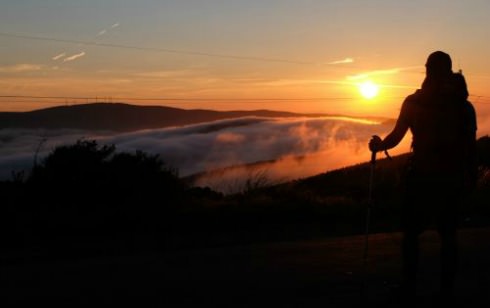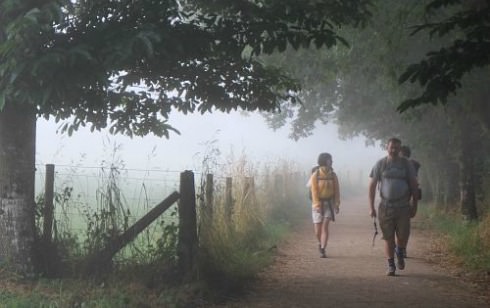Lent is a time of preparation. It should not be all gloomy but rather a time to reach out for God in new ways. In some ways it is a type of pilgrimage.
Pilgrims usually travel long distances where there is both an external and interior journey. This serious inner reflection makes it different to ordinary travel or tourism. The journey is the difficult and delightful process by which truth can be attained.
While pilgrims usually travel towards a destination, it is the spiritual journey rather than a physical location that becomes the focus. One reflects on personal dilemmas, choices about the future, the mysteries of fate, and the meaning of life. The rhythm of silence and walking opens up the mind and heart to understand and experience memories of what went before and to consider and envisage what maybe to come.
A pilgrimage takes you into unfamiliar situations to widen your horizons. The deepest experiences usually come in quite unexpected ways. For this reason, you do not measure success or failure in typical ways. True pilgrims must remain alert to recognise God’s guidance in many small things along the way. There are inherent challenges and demands. You take few belongings and in terms of luggage: less is definitely better. You endure fatigue, blistered feet, changes in weather and uncertainty about finding a bed. Endurance in the suffering fosters an emotional and spiritual well-being. Motives are cleansed by sacrifice.
 Camino de Santiago
Camino de Santiago
The Koran encourages Muslims to travel to Mecca during their life. Many Jews make pilgrimages to Israel and Auschwitz. Christians visit Roma, the sites of Marion apparitions, and the Holy Land. Some of our families have walked parts of the Camino de Santiago.
In 2010 I walked the route from Leon to Santiago de Compostela with a group from Newman College in Melbourne University. We arrived in Santiago on the Feast of Saint James on 25 July. When this Feast falls on a Sunday it is considered a Holy Year and there is a special entrance to the tomb.
When we walked the Camino, at times we hiked for hours in silence, sometimes we had spiritual conversations in pairs, and other times we just went our own way chatting as the mood took us. We had a chance to share together what happened in group reflections or our Examen. Many used our journal to memorialise in an un-self-conscious way what was happening on the exterior and interior journey. This helped us to understand more of the experience.
We also had trivial chatter and funny interchanges on the Camino. We met fascinating people from other countries and talked in pieces of other languages as we could to connect. One of the special qualities of the experience is of living and walking together. You learn a lot from the lives of others this helps you to see God and yourself at a deeper level. Pilgrims share their experience with others they meet on the journey. You must trust and be open as your encounter new places and people.

The tradition of the Camino is built around the story of Saint James. Legend has it that after the death of Christ, the disciples dispersed to different parts of the world, and that James went to Spain and spent some years evangelising there. He returned to Jerusalem and was beheaded by Herod in 44AD. Following James’ martyrdom his followers miraculously took the body to the coast of Galicia. The body was buried and forgotten for the next 750 years. Tradition has it that a hermit in the ninth century found a tomb containing three bodies and these were thought to be James and his followers. A monastery was established near the tomb and the town of Santiago de Compostela grew quickly. The journey to the shrine became one of the most important pilgrimages between the years 1000 and 1500 AD. However, plague, the Reformation, and various political factors led to dramatic decline after that.
Since the 1980s the route has attracted a growing number of pilgrims from all over the world. Some begin the route as a circuit breaker in their life, or for fitness and fun in the culture of northern Spain. Whatever the motive, most usually enter into the deeper retreat experience of the journey. Walking the Camino has become a spiritual adventure taking believers and searchers from the hustle and bustle of modern life. Together they share a beautiful landscape, a rich religious culture and generous hospitality. There is a sense of being on journey that others have walked for a long time. It is possible to travel in comfort by bus and stay in private hotels but most before prefer to expose themselves to the slow, hard journey allowing time for deeper transformation.
Many making the pilgrimage carry a shell as a symbol of baptism. Most have a passports called a credenical which is stamped at the hostel accommodation in alburgues or refugios. The stamps are necessary if the person wants to obtain a compestela certificate on completion of the Camino. A pilgrims’ mass is held in the Cathedral of Santiago and the countries of origin of those arriving the previous day are announced. A huge thurible called the Botafumeiro is swung spectacularly during mass.
 Some lessons from the Camino
Some lessons from the Camino
Those you encounter on the Way wish you Buon Camino or ‘good journey’. It is comradely and you form a sense of community with fellow travellers from all over the world. Buon Camino has serious overtones: May your time of retreat be helpful for you, may God help you when you’re suffering, may your sacrifices help you discern your life choices well. It can also have a deep sense purpose: thank you for your commitment, I’m grateful you do this for our world.
Irish poet, John O’Donohue reminds us: Tread gently on the earth. When you walk quietly and integrate the tread with the breath, you become more reflective and feel a deeper connection with creation. The gait of a pilgrim is unhurried sauntering. Saunter comes from a la Saint Terre – to be on holy ground.
It is almost impossible to get lost on the Camino because you simply follow the arrows siguela fleche. When in doubt you just ask the locals or other travelling companions. This makes for a simple and clear journey. This is refreshing change from much of the rest of life, where the unknown and unexpected demand attention and where you have to learn new skills to respond to the unfamiliar and unrehearsed. Following the clear markings of the Camino which is been taken by so many before is a kind and recreating change.
The crypt of Saint James under the Cathedral is a sublime destination. There is a tangible experience of the Holy. Curiously I surrendered readily to the mystery rather than the history and suspended my disbelief about whether the body of Saint James is actually there. It is an unusual thing to make a journey to the shrine of an apostle’s bones. Yet so many have made this journey in the middle ages and again in recent years. In doing so, many encounter afresh the mystery of faith in our connection with the spiritual – something so different to the material and the rational. There is then the question of returning home and the process of disengaging from the blessing to the experience to reintegrate with familiar world of ‘home’. It is always a disjunction. However, here or there, we are walking the Way. Buon Camino!
Peter Hosking, SJ, is the Rector of St Aloysius College, Milsons Point.